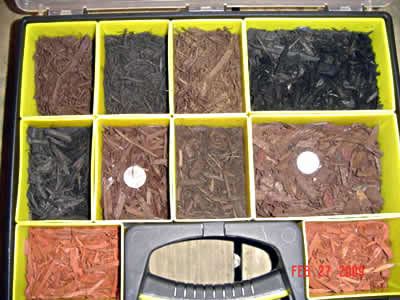Mulch Coloring
Coloring wood chips and mulch has a nice appeal to mulch producers because your margins can be very high. Proceed with realistic expectations and a little caution. At first glance, coloring mulch seems easy, profitable and exciting. If researched correctly, colored or “painted” mulch can offer a great opportunity for your company.

Most mulch is colored with a liquid dye, a non-toxic solution shipped in totes, drums or buckets. Some producers will us a dry, powder dye that is mixed in with a front loader or excavator.
Here’s what you need to get started in coloring mulch with water-based colorants:
- Reasonably priced raw materials. This is an easy step to skip and assume that all raw materials are the same price. Dried lumber, like pallets, can make a good quality mulch but you have to have a good resource for the raw material. If you have to pay “extra” for the better materials, it can eat into your margins.
- A reasonably priced source of water. Coloring mulch may require 60 gallons per minute (gpm) or more of water for the largest systems. Smaller systems may require 10-15 gpm. A pond or well typically keeps production costs low. You may want to consider using a water tank as a buffer if your well can’t keep up with your water demand. Be sure to verify your water requirements for you system.
- Know your species of wood and materials for the best quality mulch products. Specific woods and materials work better than others for certain colors. Colors other than brown and black can be extra sensitive. Dull, red mulch may not sell in your market. Your colorant supplier can help with your applications. Lean on the better companies for the best advice.
- Understand your system costs. Your coloring system may be an electric powered, stand-alone unit or a dedicated coloring unit; similar to a trommel screen or mixer. You can buy these systems new or used. Electric, stand-alone units are often used with a tub grinder, horizontal grinder or a trommel screen. These pieces of equipment agitate and mix the material for you. A system can cost a few thousand dollars up to whatever you want to spend.
- Understand your colorant costs. A quality colorant may cost from $2.40 – 3.00 per yard. (Higher volume purchases can save some money but specialty colors may require a premium charge to produce.)
For recommendations or ideas, please give us a call at GrinderTrader (330-323-1146) or fill in our contact form. We’ll be happy to offer suggestions, explain how we can make your new coloring unit more profitable or locate a used coloring unit.




